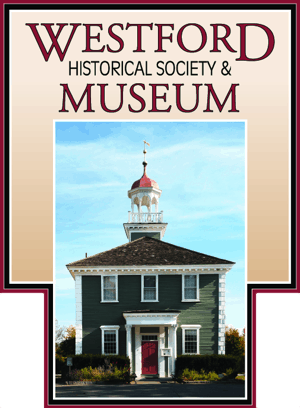
The ladies of the “Bonnet Club” from the Chamberlin Corner section of Westford gathered in 1928 for this delight photo. Number 1 is Lucinda Prescott, who lived at 181 Main Street; #2, Ruth Johnson who lived at 88 Chamberlin Road; 3, Ida Fletcher; 4, Edna Moore; 5, Julia Knowlton; 6, Annie Gertrude Sargent; 7, Helen Jenkins; 8. Margaret McKiddie; 9. Amelia Boynton; 10, Addie Parfitt; 11. Pearl Downing; 12. Suzie Osgood; 13. unknown.
Donated to the Westford Historical Society in 2002 by Millie Johnson, daughter of Ruth Johnson.
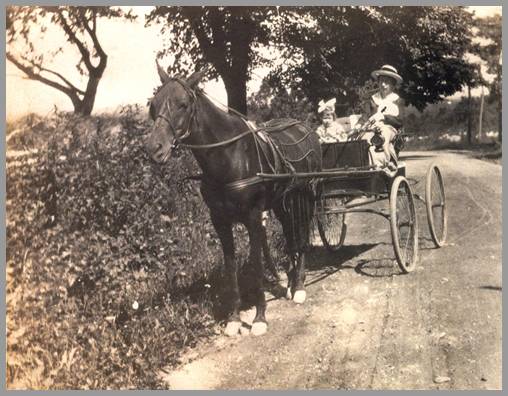
Harlan and Julia Knowlton bought and moved into the house at the northeast corner of Chamberlin and Hunt Roads in May 1919. They had three daughters – Harlene, Gladys, and Priscilla. Priscilla, born a month after they moved in, married Kenneth Hill in 1941, and together they carried on the orchard business begun by her father, Harlan Knowlton. This became known as Hill’s Orchards. In 2000 the town of Westford bought the property and turned it over to the Conservation Commission. Priscilla (Knowlton) Hill kindly loaned this photograph to the Westford Historical Society with the caption: “Mother, driving Maude, taking us to Sunday school.”.
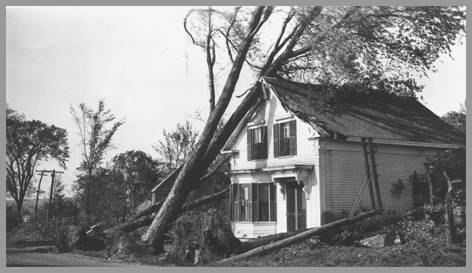
Two weeks ago we highlighted the “Bonnet Club” from Chamberlin Corner. One of the ladies in the Bonnet Club was identified as Ida Fletcher. Here is her home at 184 Main Street after the Sept. 21, 1938 hurricane roared through. This scene was repeated all over town, the Merrimack Valley and up through Peterboro, NH. People had no idea a storm of this magnitude was coming. Hitting just at peak harvest time, the apple crop, as well as other fruit crops, was a disaster, not to mention massive devastation to homes. Power outages lasted for weeks and clean up went on for months.
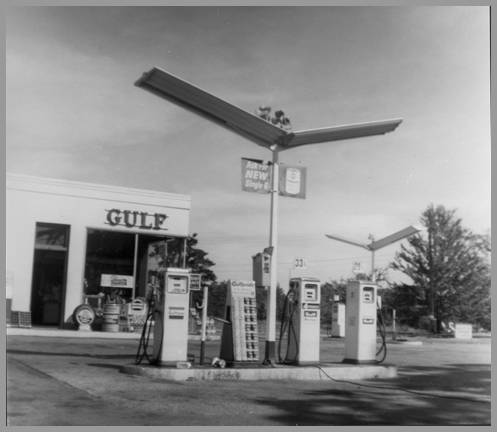
Pete Morrow Nab
Pete Morrow’s Gulf station located in Nabnasset.
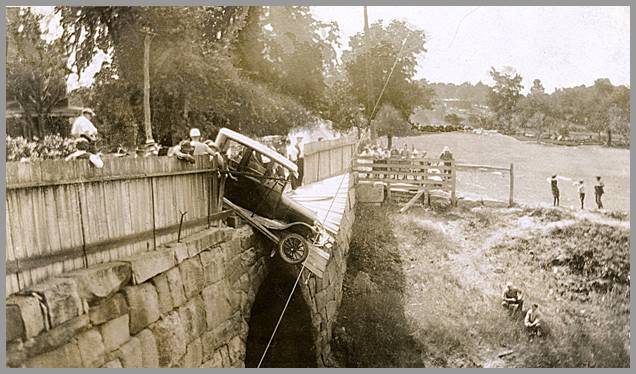
John Wright, now of Keyser, WV and grandson of Emma May Wright, provided this wonderful story behind the picture taken at the bridge on Graniteville Road.
On June 17, 1921, Emma May Wright, who lived at 40 North Street, was a passenger in her 1920 Model-T Ford being driven by her nurse-companion, Mrs. Emma Weeks. Coming easterly on Broadway, Mrs. Weeks attempted to make a right-hand turn onto Graniteville Road and the bridge over the Boston and Maine railroad tracks. Somehow she failed to straighten out the wheels, which resulted in an apparent U-turn almost over the edge, while the undercarriage of the car catching on the side of the bridge prevented its fall to the tracks below.
Family tradition says that they were trapped in this vehicle for a considerable period while they watched two Boston and Maine fast freights pass beneath them. [It looks empty by the time this event was photographed.]
The car was eventually hauled across River Street to Furbush’s Garage, where repairs totaling $47.20 were made. Mrs. Wright also received a bill from the Boston and Maine Railroad for $71.56 for “…repairs to fence on Bridge at Graniteville, Mass., broken by your automobile…”
Expenses recorded in Emma Wright’s journal for June 23 read: “Paid Mrs. Weeks final payment, – 2 weeks, $12.00.” On the same day she paid out $2.00 to obtain her own Massachusetts driver’s license. Emma Wright would not drive it many years as on November 23, 1926, the car was loaded on a rail car and transported to Washington, D.C., to the home of her son, Clarence D. Wright, where it remained, undriven, until it died. The freight cost was $42.00 for its final trip.
You may have seen an original of this photograph hanging in the waiting room of North Street Automotive. Many thanks to John H. Wright for sharing this photograph and the story behind the picture.
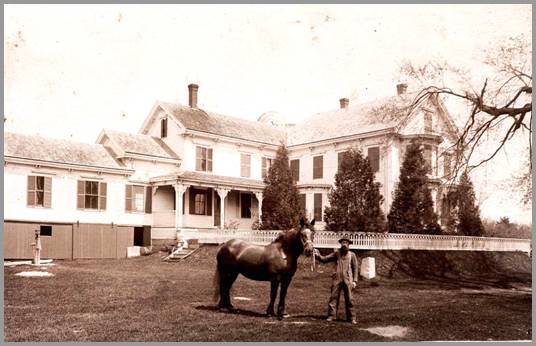
Labeled “Almon Vose House,” this was print number 379, taken in 1899, by the A. W. & G. E. Howes brothers, photographers of Ashfield, Mass. Alvah, Walter and George Howes, between the years of 1882 and 1907, canvassed Massachusetts taking photograpic plates. 23,000 of these plates are still at the Ashfield (MA) Historical Society! Take a look at the back of your old mounted photographs and see if you have a Howes Brothers print.
Quoting from Mary “May” G. Balch’s “Parkerville Notes,” she wrote, “While the town was a part of Chelmsford, a winding road [Old Lowell Road] was built from Chelmsford in 1663. Originally, it came as far as the Hutchins place, now owned by the Priests….” The Hutchins place was also the Almon Vose house mentioned above. Gladys McCallum updated May’s “Notes” in 1962 adding, “The home was bought about 1959/60 by a builder, Arthur Mitchell, and renovated into a two-family home. Mr. Mitchell rents these apartments.” That object peaking over the roof is not a satellite dish, but Mr. Vose’s windmill. Did you recognize the house in the picture? Today it is painted yellow and is at 20 and 22 Old Lowell Road?
The house is now owned by Shelly Kick and Walter Czarniecki. Walter has
done an incredible job of restoring the old farmhouse.
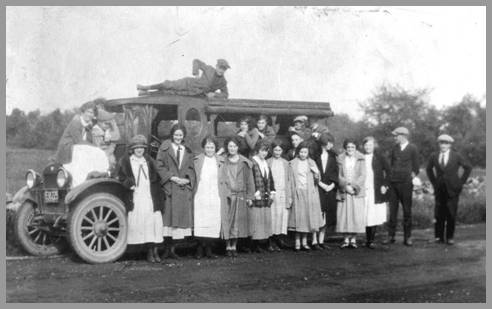
Back in the 1920s, there were six school barges (buses) that transported children from the far corners of town to Westford Academy and the Frost school in the center. George Goucher’s route covered Forge Village, George Burke’s was the north part of town, Bert Hildreth covered Concord, Littleton and South Chelmsford Roads, Clarence Hildreth covered Parker Village, Carl Lydiard covered Graniteville, and Everett “Buzzy” Miller did the Brookside region.
Bert Hildreth picked up students at the Parkerville School and brought them to either the Academy or the Frost School. These children would have already walked from their homes to get to the Parkerville School in time for a ride. Students from the Chamberlin Corner area would have walked over to Brookside for their ride.
Those very early buses, called school barges, were not much more than open trucks with two rows of benches placed along opposite sides where students sat facing each other. A rope across the back with an older student guarding the opening was all that kept the little children from falling out the back end. Many barges also served a dual purpose. George Burke was known to bring cattle to Fisher’s butcher shop, at what is now 3 Depot Street, in the same vehicle he would later in the day use to transport students back home. A quick wash with a bucket of water and scrub brush, and he’d be ready to do the afternoon bus run.
Geoff Hall recalls, by 1954, there were eight buses in use when he began first grade at Sargent School in Graniteville. “Fisher “Bucky” Buckshorn was our bus driver for many years. I don’t know what it was, but Bucky always had the oldest, beat-up bus on the route. All the other drivers had new buses, but not Bucky.”
Many thanks to Geoff Hall for sharing his recollections and to Roland Pendlebury for providing this picture of George Goucher’s bus. Roland’s sister, Rita Pendlebury, is one of the ones leaning out the side window.
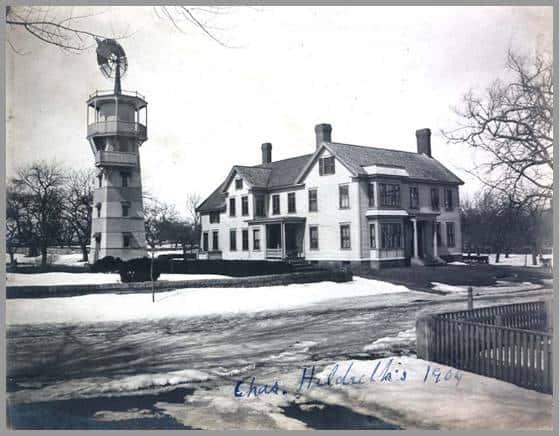
Standing in the driveway at 8 Hildreth Street in 1904, Quincy Day, using his Adlake camera, captured the house and windmill at 7 Hildreth Street then owned by Charles L. Hildreth. Today the house minus the windmill is owned by David and Jean Owens. Windmills heralded indoor plumbing. John W. Abbot had the first windmill, tower and tank, valued at $800, in Westford as early as 1885 according to the tax valuations for that year. By 1905, tax valuations reveal five more windmills in town, including the one of Charles L. Hildreth, shown above. In fact, the windmill now at 7 Hildreth Street was featured on page 14 of the 1895 catalog of Fairbanks, Morse and Company. The caption under the picture stated, “Erected on the estate of Charles L. Hildreth, Westford, Mass.”
Utilizing wind power, the blades would turn. This action moved gears that pulled a pump rod up and down, which would force the well water up the pipe to fill a wooden storage tank near the top of the windmill. Gravity would then let the water flow from the wooden storage tank into a copper tank in the attic of the home. What a major improvement in the life of the housewife. By 1907, a private water company, The Westford Water Company, was formed, and a standpipe on Prospect Hill served 217 water takers in the center. As The Westford Water Company expanded its lines, individual windmills were no longer needed. In 1956 the Town of Westford purchased the Westford Water Company, and today the occasional windmill turns only our thoughts back to the way it must have looked in Westford one-hundred years ago.
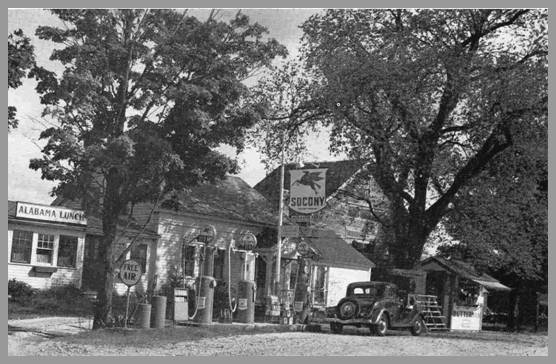
Alabama Farm, located at 145 Littleton Road in Westford, just east of Applebee’s, served the traveling public from the 1920s to the 1950s. In 1925, Frank Hartson was the owner. He was taxed on 30 acres, his house, barn, store, henhouse and gasolene pump. The store evolved into a little restaurant, and according to Dick Lamburn, was one of the few place coming out from Lowell that served food. Their specialty was a chicken plate. The place was so popular that Mr. Hartson and his wife put an addition on the end of the house for more picnic tables. Helen Garrigan, now 93, worked there in 1928 when she was a senior in high school. One of her duties was tending the gas pumps.
The next owner of interest was Doris Poté. She was a lawyer in Boston and her mother, Margaret, ran the restaurant. By the early 1950s, an ice cream stand and grill had been added. Sam Richards, Jr., worked here part-time while going to college during the 1950s. He remembers making ice-cream sodas and grill cheese sandwiches.
Vinson and Mildred Reid lived at 31 Tadmuck Road. Vinson was a poultry farmer and fruit grower, best known for his peaches, although he also grew apples, plums and pumpkins. In the 1957, they purchased the property at 145 Littleton Road, called Alabama Farm, renamed it Reid’s Fruit Farm and began selling his produce at the stand. Vinson Reid died in 1990 and Mildred died in 1998. Gone are the hens and henhouses, the gas pumps, the roadside stand and the house which was demolished in April 2002. Only the building visible to the right behind the Socony sign survives, as it is the red barn which was moved from the Alabama Farm/Reid Farm at 145 Littleton Road to Floral Arts at 129 Littleton Road on November 16, 2003.
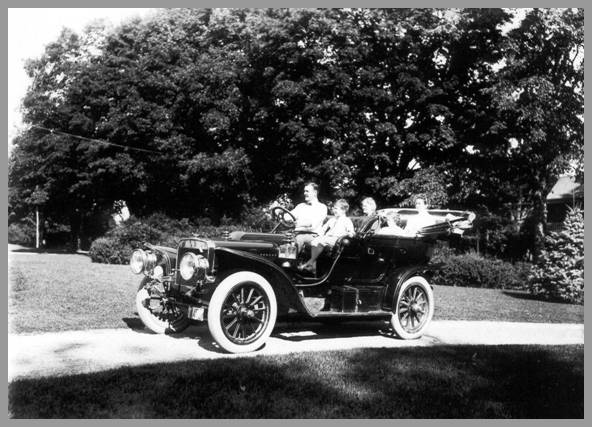
On April 23, 1908, The Boston Herald ran a photograph of the Donald C. Cameron family with the following brief article. “A large touring car owned by D. C. Cameron of Lowell was run aboard the steamship Cymric yesterday shortly before she sailed for Liverpool. Mr. Cameron and his family, accompanied by H. S. Bacon, also of Lowell, and Miss Martha J. Taylor of Westford, will use the auto in a three months’ tour of Great Britain with a side trip to France.” On May 16, 1908, The Westford Wardsman reported that the Cymric had arrived safely at Queenstown after a nine day’s voyage. “Among the passengers were Donald Cameron and family.”
Although the Cameron’s permanent home was in Lowell, Westford was their summer retreat. So, back home in Westford, on a sparkling August morning in 1908, Charles Hildreth captured the Donald Cameron family out for a drive in their touring car, tentatively identified as an Oakland (shown above). As the top was folded down, one can see Donald Cameron behind the wheel of his right-hand drive vehicle with his son, Donald Fiske Cameron, age 8, at his side. The child seated in the back seat is Donald’s daughter, Mary Eleanor Cameron, age 6, with her mother, Meta (Fiske) Cameron. The other lady in the backseat is the children’s grandmother, Josephine Fiske. Taken from the side yard at 39 Main Street, the porch of the Wright and Fletcher store at 40 Main Street is visible in the background.
John Sweeney, Director at the Lars Anderson Auto Museum in Brookline, Mass., says, “Cars of this type and period often were priced in the six to ten thousand dollar range, for the first decade of the twentieth century. For the first few years, Oaklands sold for $1,300 to $1,600, and were built in Pontiac Michigan. Most likely, if an Oakland, it was ordered from out of the region, and shipped to the buyer.”
Oh, that the car could talk and tell us of the sights it saw in Europe and back home in Westford of almost 100 years ago. (The photograph is from a glass plate negative from the Charles L. Hildreth collection, on permanent loan to the Westford Historical Society by the Paul MacMillan family.)
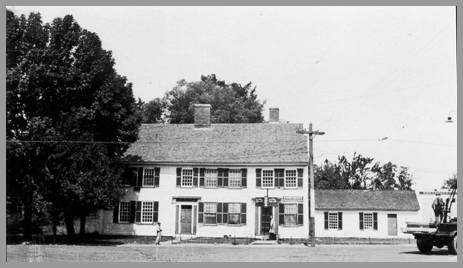
This 1929 photograph shows the Prescott Tavern in Forge Village located at the intersection of East and West Prescott Street. In a 1989 article written by Gordon Seavey for the Westford Eagle, he stated that Luther Prescott who died in 1885 at 75 was probably the last keeper of the Prescott Tavern. This large tavern not only had rooms for the many teamsters that traveled the north-south route from New Hampshire to Boston, but there was a dance hall on the second floor. By 1897, the building was no longer in use as a tavern. As the years went by, other businesses began to use the building. There was a barbershop upstairs run by William Marcouillier from the 1930s to 1967. His son, Lionel, barbered there as well. “Kate” Hanley had a yarn shop downstairs. A store and post office were in the east end of the old tavern. Daniel Splain’s store was listed here in the 1897 Westford Directory. He was selling everything from groceries to stationery supplies to boots and shoes. In 1897, John Splain, brother of Daniel, was the postmaster, assisted by Mrs. Mary E. Nutting. Later postmasters were Eva Pyne, Burton Griffith and Josephine Connell, who was postmaster in Forge from 1925 until 1965. She worked first at the Tavern location and later at the new post office on W. Prescott Street. Her son, Robert Connell, was postmaster in Westford Center from 1974 until his retirement.
It was a sad day in town when the old Prescott Tavern was demolished July 29, 1976. Today, a new building sits on the site which includes Spinner’s Village Store and business offices upstairs.
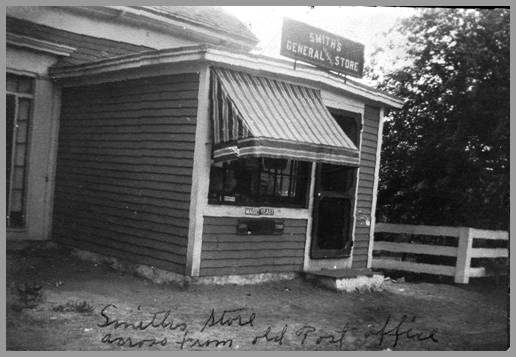
Smith’s Store across from old Post Office. This photograph remained a mystery until retired Westford postal worker, Robert Abrahamson, came to our rescue to tell us that the “old post office” serving Nabnasset/Brookside until about 1958 was in the building which is now a residence at 32 Brookside Road. The house with Smith’s Store, shown above, was at 27 Brookside Road. It was bought by Elizabeth Smith in 1915 and valued at $700. In 1925, Elizabeth sold the property to William Donnelly and that year his tax valuations included the store and a gasolene pump. Next, Virginia Burnham contacted Grace (Bolyea) Sanborn who was born in 1930 in Westford and lived at 20 Brookside Road. Grace said she remembered the store having bread and lots of candy for sale. She also mentioned the gas pump. Today the Sousas live here and all evidence of a store is gone. Thank you, Bob, Grace and Virginia for providing answers and preserving the history of Smith’s Store.
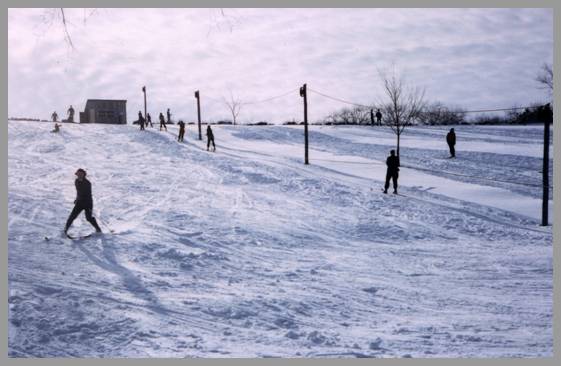
Before the Nashoba Valley Ski Area opened in 1964, Westford boasted a rope tow ski lift on Blake’s Hill on Boston Road. It was located almost opposite Crown Road, and for a few years after it was closed, one could see the poles still standing (well, maybe leaning), with their attached pulleys. According to Shirley MacDougall, many Westford kids learned to ski here, well before Nashoba Valley opened. The Westford Ski Tow was “the place to be” on a sunny, winter Sunday afternoon. Stephen MacDougall, 47 Boston Road, built the tow about 1955 and operated it until 1969. He used a 1946 Ford V-8 motor located at the top of the hill to power the tow. It was housed in the shed seen in the photograph but that, too, along with the warming hut has met its demise. Looking at the overgrowth there now, it’s hard to imagine skiing down the front of the hill! Thank you to Dick Kenyon who obtained this information and photo from an interview with Steve and Shirley MacDougall.
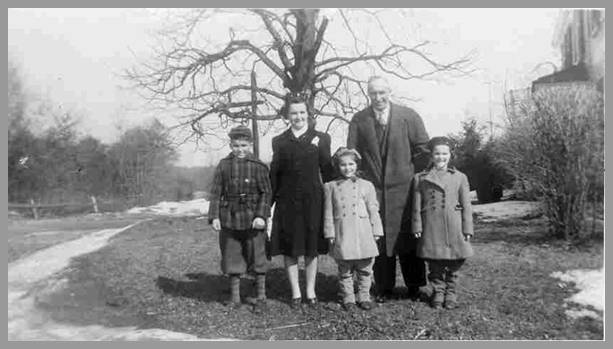
The Kimball Family about 1941. Left to right, Stanley, Clara, Beverly, John “Jack” and Barbara “Bobby” Kimball. Just prior to 1913, George Kimball attended an auction at the farm at what is now 400 Littleton Road with the intention of buying a cow. He must have had his eye on this property, for in 1913 he bought the whole 93 acre farm.
On April 19, 1939, George Kimball’s son, Jack and his wife Clara, (in photo above) opened Kimball’s Ice Cream Stand in the carriage shed of the house. Clara said that Route 110 was a poor place to have a business, not enough traffic. Little did she know! In the early days, the family would park old farm equipment and cars out front so people would think business was good. Starting with family members making and scooping ice cream, today Kimball’s Farm Ice Cream and Country Store employs approximately 450 part-time employees. George’s great-grandsons, Michael and Peter, now head up the operation. With the driving range, pitch and putt, mini-golf, bumper boats, and the lunch and grill function facility, the family no longer needs to park old farm equipment out front to look busy. And the Kimball Special is as good as ever.
(Photograph donated by Constance English, former director of the Westford Historical Society)
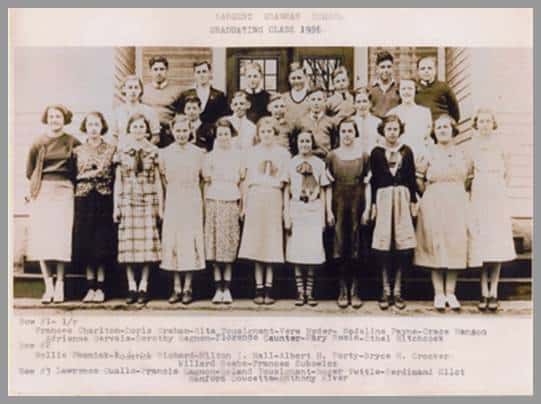
Sargents Grammar School – Graduating Class – 1936
This photograph includes Manford Doucette who is the uncle of Blanchard Middle School principal Jack Doucette. Photo is from Bryce Crocker’s private collection, which is being shared with the 275th Celebration Day Committee.
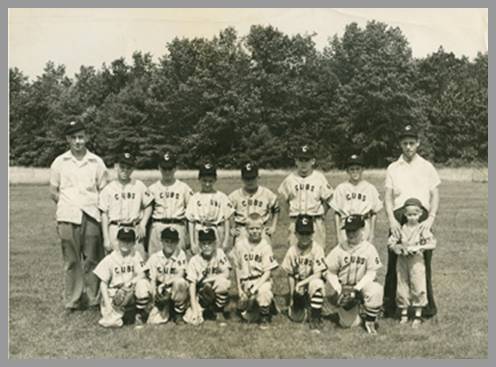
1952 Cubs
Front Row- left to right 1. Kenny Paul, 2. Buddy Leedberg, 3. Bruce Lefebvre, 4. unknown, 5. Don Reeves, 6. Vaughn McLenna, 7. Jimmy Leedberg (bat boy).
Back Row- left to right 1. Bob Cassidy, Asst. Coach, 2. Richie Gingras, 3. Brian Mulligan, 4. Gerry Cassidy, 5. Wally Beede, 6. Timmy Sullivan, 7. Melvin Leedberg, 8. Waldo Leedberg, Coach
Baseball has always been a tradition in Westford, opening day is April 24th – PLAY BALL! Waldo Leedberg was a coach in Nabnasset for many years. He and his wife, Margaret, continue to call Nabnasett home plate!
Photo is from Waldo Leedberg’s private collection, which was shared with the 275th Celebration Day Committee.
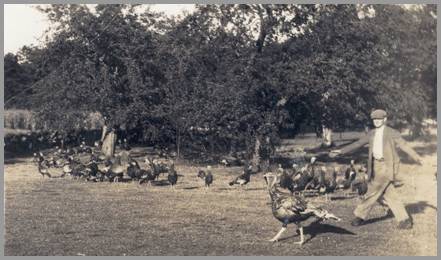
Dances with turkeys… Everett Jarvis rounding up turkeys.
In 1896, Everett Jarvis married Florence “Flossie” Blaisdell. They would live at 62 Griffin Road, where he was a farmer. Everett’s tax valuation for 1905 listed his property with 22 acres and his animals – a couple cows and horses, and some poultry. Everett is in the photograph, above, rounding up an errant turkey. Everett and Flossie had a son, Frank, born in 1906. Frank attended the Parkerville School and in 1924, he graduated from Westford Academy. He then continued his education and graduated in 1928 from Boston University College of Liberal Arts. At 59 years of age, Frank married, for the first time, Edith “Edie” Horskin. They had no children. Frank and Edie continued to live in the old house at 62 Griffin Road where he operated the small farm. For many years, theirs was the only house on the road. Time marched on, and by the 1990s, most of the Jarvis property was sold and Jarvis Way with at least a dozen new houses was built. After their deaths (Frank in 1998 and Edith in 2001), their house was demolished. At a time when Westford laments “no affordable housing,” how sad and short-sighted that so many little old farm houses which define a neighborhood, lend character and history, and have stood for so many years are carelessly destroyed.
(Undated photo from the collection at the Westford Historical Society)
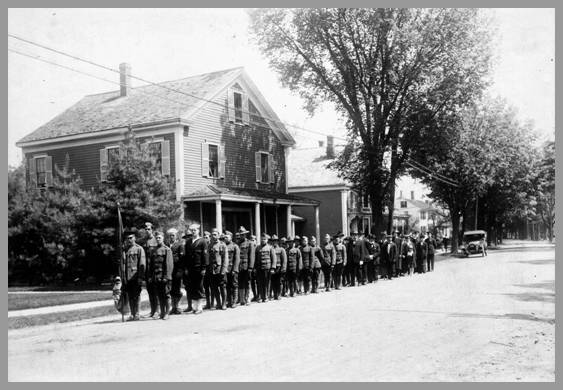
This photograph found in the Historical Society files was labeled “Memorial Day Parade, 1920.” When the Hildreth glass-plate negative collection arrived at the museum, there in the collection was the original plate – except the envelope was labeled Apple Blossom Parade 1936. As the King of Siam said in The King and I, “‘Tiz a puzzlement.” Whether 1920 or 1936, Westford veterans paused for the photographer who must have been standing at the easterly point of the common. The leader has a wreath in his right hand probably to be placed at the Civil War monument as the War Monument directly in front of the library was not erected until 1924. Near the back of the line of march one can just see the very elderly veterans with their beards, now white. The large building in the foreground was the store of Peter Swallow. It had an apartment above. According to the History of Westford, p. 250, the store was moved to this site. In 1865, Sam Wiley lived in the house just beyond. He was a store keeper in the Swallow store. Eventually the store building came into ownership of the Seavey family, and Marden Seavey turned it into two apartments. It was demolished around 1964. The little house just beyond, where Sam Wiley lived, was also owned by the Seavey family when it burned in 1939. If you’re still trying to figure out where the store was – today you drive right over the spot every time you use the driveway at the J. V. Fletcher library.
Based on the car in the background, 1920 is probably the correct date for this photo, however, if anyone happens to have a copy of this photo, with names, or can confirm the date, please contact the museum.
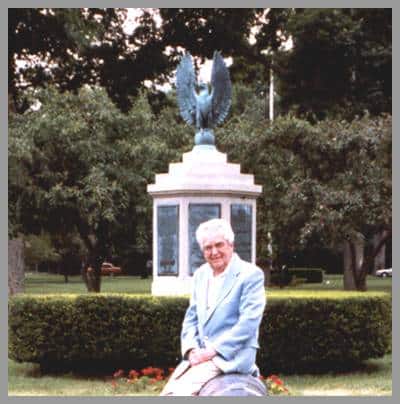
Early in 1924, the town voted to spend $6,000. on a war memorial. A committee was chosen, and in November that same year, the eight-sided monument, shown above, was placed on our Town Common. The design chosen for the monument came from Henry L. Norton, Winthrop, MA in collaboration with Thos. Byrd Epps, of Boston. The design had the approval of the Massachusetts Arts Commission and Ralph Adams Cram, a well-known Boston architect of many churches in the area. Many do not realize, though, that Cram had connections to Westford. His father was William Cram who was the minister at the First Congregational Parish (now the First Parish) from 1872 to 1876, so it is no surprise that Ralph entered Westford Academy in 1875. According to the Memoirs of Kate Hamlin, Ralph and Albert E. Prescott, who lived at 21 Main St. in the house known as Mille Fleurs, were life-long friends. Because Rev. William Cram had made a promise to his parents to come and take care of their farm if ever needed, in 1876 he was called home and “abandoned a successful pastorate in Westford, much to the chagrin of his bitterly disappointed wife.”
The granite for the six-foot six-inch base came from the quarry of Palmer & Sons in Graniteville. Because Westerly, RI granite is famous for its white statuary qualities, it was selected for the pedestal. Surrounding the Westerly granite are eight bronze plates dedicated to all the men and women who served their country from Westford. The bronze eagle on top is over four feet tall.
Writer and town historian, Gordon Seavey (1905-1996), is also shown above, seated on the cannon from Morro Castle.
You can read more about Ralph Adams Cram in the book entitled, Boston Bohemia, 1881-1990 Ralph Adams Cram: Life and Architecture written by Douglass Shand-Tucci and published in 1995.
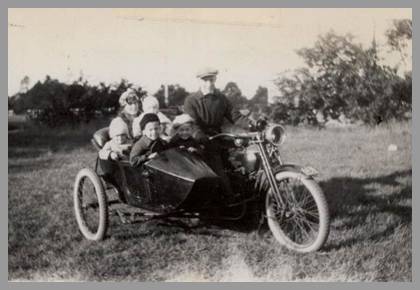
The Crocker Family Chariot of 1923.
We have shared a few photographs of the various forms of transportation used over the years. We think you’ll agree that this is the most unique!
The driver was James H. Crocker. His passengers, front left, Morris with J. Richard. Mother holding Bryce, and David at her right. With gas prices at an all-time high, this may be the best way to beat the gas prices these days.
Photo is from Bryce Crocker’s private collection which is being shared with the 275th Celebration Day Committee.
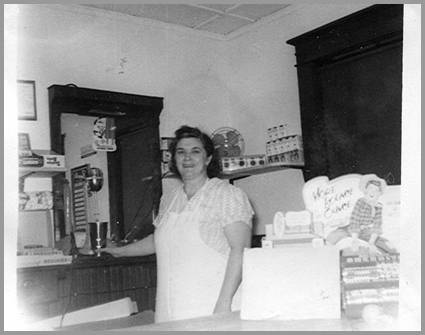
Jeannette (Leduc) Homes – 1955
Jeannette Holmes ran Holmes Variety from her home at the corner of Second Street and Broadway Street in Graniteville from 1948 to 1955. Ice cream and candy were big sellers at the store. All the neighborhood kids have fond memories of being able to dunk their ice cream cone in the big bowl of jimmies on the counter.
Photo is from Janet (Holmes) Dutton’s private collection, being shared with the 275th Celebration Day Committee.
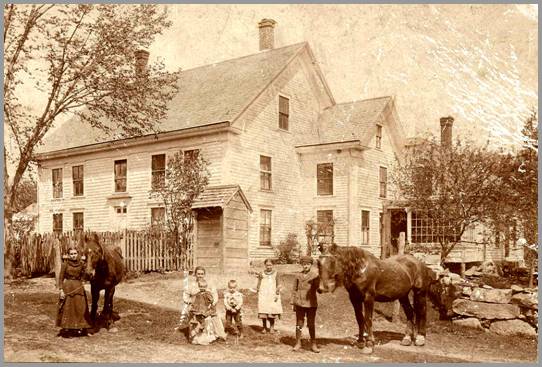
Several months ago we mentioned the Howe Brothers of Ashfield, MA who had done extensive photography throughout Massachusetts in the late 1800s. The photograph above was print #376 taken by them in 1899 and is of the Blaisdell farm on S. Chelmsford Road. Remnants of the house and barn foundations are still visible in the field opposite the intersection of Blaisdell Road. The original Jacob Blaisdell was born in 1787 at Carlisle and in 1841 had his 14th child by his third wife. Jacob’s grandson Joel Alvin Blaisdell also had a large family of 11 children, and they are the ones who lived in this house. Several Westford families were joined in marriage with the Blaisdells. It was Joel’s daughter, Florence who was the mother of Frank Jarvis who lived on Griffin Road. Joel’s daughter Lillian married James O’Brien and they lived on Providence Road. Joel’s daughter Augusta married Thomas A. E. Wilson and was the mother of Marjorie, Raymond Mary and Kenneth Wilson. Some of the Wilson property is now Wilson Farm Road and Atwater Drive.
Joel died in 1921 and ownership of the property continued through his wife, Elizabeth Hutchins Blaisdell. In 1925 she was taxed on 209 acres. By 1961, Joel and Elizabeth’s son, Chester, born in 1896, sold the Blaisdell farm and LaSallette Village was built by Francis Corcoran. The development included houses on Craig Circle, Blaisdell Road, Vose Road, LaSallette Road, St. Mary’s Drive, and Tadmuck Road. The development went down S. Chelmsford Road to Cowdry Corner and turned onto Old Lowell Road where a few more homes were built. Mr. Corcoran also built Chester a house and small barn at 14 S. Chelmsford Road. The barn was so that Chester could still keep a few cows. Chester died in 1970 and the house is now the Early Childhood Learning Center and is part of the Nashoba Valley Technical High School complex.
Many thanks to Helen Garrigan, who is a niece of James O’Brien, and her nephew, Charles McColough, for sharing this photograph for the 275th Celebration series.
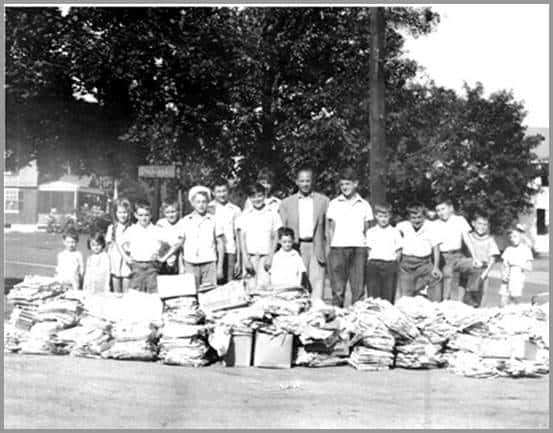
Cameron School Paper Drive – Forge Village – Orchard Street Gang – 1945
Left to Right 1. Thomas Haran, 2. Ann Haran, 3. Helen Hartley, 4. John Mulligan,
5. John Hartley, 6. Clarence Connell with the hat, 7.Walter Halko, 8. Conrad Heroux, 9. standing behind Conrad unknown, 10. Joseph McKniff, 11. Principal Peter Perry, 12. Claude Provost,
13. Francis Courchaine, 14. Marcel Brule, 15. Richard Lyon, 16. Steve Haley, 17. unknown.
As early as August 12, 1916, the Westford Wardsman reported that “The conservation committee of the Tadmuck Club, consisting of Mrs. H. E. Fletcher, Mrs. H. V. Hildreth and Mrs. H. D. Wright, took the very original method of raising funds for their work by asking the members to co-operate in saving their newspapers, magazines, etc. These were to be tied in bundles of about twenty-five pounds each.”
As one can see from the Wardsman article, recycling has been practiced in Westford for many years, even the Cameron School children were into recycling in 1945. Please continue the tradition today at your home! Recycle, please!
(Photo is from Paul MacMillan’s collection, which is being shared with the 275th Celebration Day Committee)
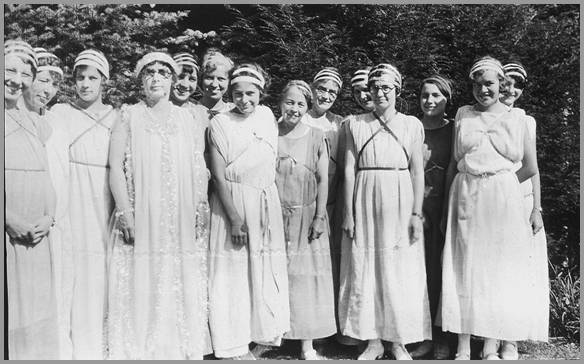
In The History of Westford, there are several pages which tell about many of the early families which left Westford and migrated to other states. From the tableau called “Migration” in the 1929 Pageant, pictured above, are (left to right) Lillian Sutherland, May Day, Helen Graig, Edith Wright, Alice Socorelis, Alice Heywood, Mary Wilson, Ruth Tuttle, Frances Fisher, Alice Day, Elva Rollins, Marjorie Wilson, Dorothy Heywood and Lillian O’Brien.
On September 21, 22, and 23 in 1929 Westford celebrated its 200th birthday. Sporting events, a band concert and dance, special Sunday services, planting of an anniversary tree, and a pageant highlighted the anniversary of Westford’s founding. The pageant was held in an open field on the right-hand side of the road as you go down Hildreth Street. The audience sat in folding benches against the hillside looking down into the field. Cecil B. DeMille couldn’t hold a candle to this production. Mr. & Mrs. Lucius Charles Fairchild wrote and directed The Pageant, which included 25 episodes representing Westford’s history from the time of the native American’s through World War I. Actors were many of the town’s notables. Two of those who took part and who are still living in Westford today are Arnold Wilder, born in 1909 and Huntington Wells, born in 1913. Arnold represented “Pestilence,” in episode 9 entitled “The Revolution,” and Huntington was part of “The Spirit of ’76” in episode 11. Arnold still remembers parts of the costume he had to wear as Pestilence. It included long fingernails held on with adhesive tape. Then on Sunday, while many of the adults were dressed as Pilgrims to attend church in the center, he and Claude Wright, dressed as Indians, rode up to the church on horseback. Arnold said Bessie, his horse, definitely took a dim view of the flapping Indian blanket he was wearing. The Indians were invited to attend church, but they had to sit with the other “Indians,” relegated to the upper balcony. Many thanks to Arnold and Huntington for sharing their memories of 75 years ago as Westford celebrates its 275th anniversary.
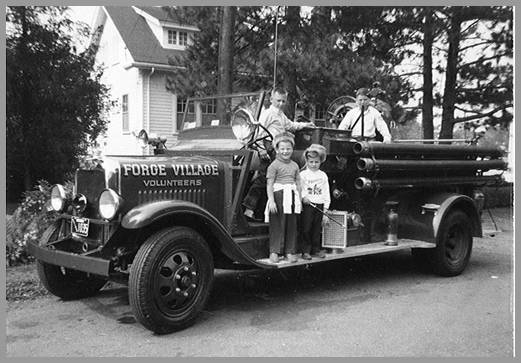
Thanks to Nancy Cook and her brother, Ken Greenslade, for supplying the names of the youngsters: Ted Greenslade is standing in the cab, and George Young, Jr., is standing in back. On the running board (left to right) are David and Stephen Balfour. The picture dates to about 1960 and was taken in front of 5 Forge Village Road.

The Westford Athletic Association dream team of 1906-07. On January 22, 1908, the “Lowell Courier-Citizen” ran this picture with a brief article explaining that Westford’s Athletic Association baseball team had won 30 out of 40 games played in the 1906-07 season. The article said they were the “undisputed champions of Northern Middlesex… and had taken the laurels from many of the semi-pro teams throughout the Stony Brook valley.”
In the front row, left to right: Herbert Fletcher, 1B; William E. Wright, lf; Joe Butler, p; Warren Wright, ss; Eddie Vaughan, c. Back row l-r: Riley, catcher and/or cf; Clark, 3b; Alfred Hartford, mgr.; Capt. Mike McGlinchy, 2b; Reuben Taylor, rf. Two who were not in the photograph were Edward DeFoe and Shirley Clark.
Of the players we could find birthdates for, only one, Warren Wright, was still in his teens. Taylor was 29 and McGlinchey was 30. They were literally a farm team, made up of strong, local farmers. Alfred Hartford had an insurance business on the side, operating out of the Wright and Fletcher store, now Sweet Peas; Herbert Fletcher was actually John Herbert Fletcher who later ran the store on Lincoln Street begun by his grandfather, John B. Fletcher; Reuben Taylor later lived in the remodeled schoolhouse on Stony Brook Road, was a Trustee of Westford Academy, and was on the board of directors of the J. V. Fletcher Library. However, it is William Wright most will connect with, as he was one of the founders of the Apple Blossom Festival in 1935.
Many thanks to Mr. and Mrs. John MacPhail for recently donating this picture to the Westford Historical Society.
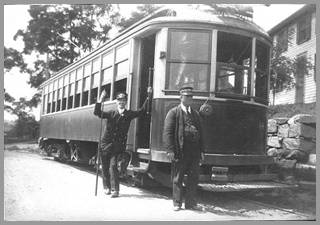
Almost 100 years ago, Westford had three railroad lines with eight stations and two trolley routes in town. The main trolley line which opened May 31,1906 was an interurban line which ran from Ayer to N. Chelmsford. The back section of the building at 2 East Prescott Street housed the electrical equipment for the trolley, converting electricity from AC to DC for trolley use. At one time Joseph Connell was the caretaker of this power station. On the stretch from Forge Village to Graniteville, the trolley tracks ran parallel to the railroad, coming out between 94 and 98 N. Main. It then went along North Main Street, down Beacon and crossed Nutting Road where the old bridge abutment still exists. Next it crossed Dunstable, Tyngsboro and Forrest Roads, eventually coming out on Groton Road (Rt. 40), to connect with the Boston and Northern Street Railway Company at North Chelmsford. Cars operated in both directions almost hourly. According to Arnold Wilder in an interview with June Kennedy, “The mill workers in town would go to Lowell once a week, on Saturday. The schedule was such that they would work from six until twelve on Saturday, have time to go home and get their clothes changed and catch the one o’clock car [trolley] for Lowell, or train.”
The other line in town was a branch line which opened on May 25, 1907. It started at the Triangle Store on Groton Road in West Chelmsford, went to Nabnasset and then to the Brookside Mill area and stopped. B&M officials would not allow the trolley to cross their railroad tracks. Passengers were required to cross the tracks on foot and hop on another branch trolley that would then travel from Brookside, along Lowell Road, up Cummings Road to Depot Street and finally to its terminus in front of the J. V. Fletcher Library on Main Street.
Imagine the surprise of the two school teachers at the Tadmuck School (20 Boston Road) that day in May 1907 when they went to call their students in from recess and not a one was in sight. They were all at the town common, acting as an impromptu Reception Committee for the trolley!
Several Westford men worked on the line as conductors or motormen, among them Alfred Tuttle who lived at 14 Boston Road, J. Edward “Hunka” Clement, afterwards a School Bus operator. Walter Cutter and J. Edward Sherlock were featured as the crew in an early photograph near the Fletcher Library. Lastly, Ed Szylvian, of Westford, remembered Jack Daffy as one of the conductors. Jack would later be a ticket taker at the Ayer Playhouse theater.
In December 12, 1911, the “Westford Wardsman” reported that “The trolley cars have been crowded during this week, many people from this village going to Lowell and Ayer for their Christmas shopping.”
The years of trolley service were not many. In order to entice ridership, amusement parks such as Whalom Park, Canobie Lake Park, and Lakeview were built to become weekend destinations. Our summers are too brief, and even that didn’t create enough business, and ridership continued to dwindle. The trip on the Brookside trolley line to Lowell which took over an hour and required two changes, took only twenty minutes by train and cost only a few cents more. At the same time, the automobile was becoming serious competition to both the trolley and the train. Without enough customers to support the service, the branch line from Brookside to the center was out of business by 1920. The line through Graniteville and the branch from Brookside to the Triangle Store survived for a few more years. The Eastern Mass. Street Railway took over those route in 1926, but suspended car service on July 9, 1929. Eastern Mass. Railway then furnished bus service until terminating even that service in 1932.
Today, one finds it hard to believe a little, yellow trolley car called the “Jolly Jumper” used to make its way up the hill to Westford Center, and the ride to Lowell only cost a quarter.
Many thanks to Arnold Wilder, Ed Szylvian and to Alex Belida (1918- 2001) for sharing and recording their memories of Westford’s trolley history.
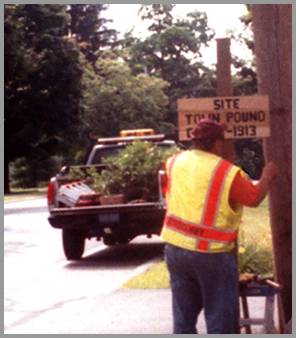
WESTFORD’S EARLY TOWN POUND
In Westford’s early years, records of 1776 show a Pound was established to confine stray animals. It was a public enclosure built of wooden fencing in the early days and of heavy stones in the later years. This reference listed 16 sheep and five lambs but without a location identified. A fee was charged for the redemption of impounded animals.
In 1717, Jacob Wright fettered a ‘black hors on common’ (a fetter being a chain or a shackle).
By 1773 a legal Town Meeting was held to provide a place for a new Town Pound. Finally, by 1817, a 1600 square foot plot of land was sold to the Town for $10.00 by Theodore Peabody conveyed by deed “where the present pound now stands” on the Westerly side of Boston Road just southeast of the Common.
In 1843, Ephraim Wright was appointed Pound Keeper and was paid for rebuilding the Pound, for splitting 12 stones and painting the gate.
In 1913, the Town would vote “to release and convey a parcel of land on the Westerly side of Boston Road formerly used as the Town Pound” to Charles L. Hildreth. This is now 25 Boston Road.
A personal note: When my family moved to 24 Boston Road in 1967, I remember a herd of cows coming from the back fields, through our barn and out onto Boston Road. Two young men voluntarily and with pleasurable excitement herded the cows up to the Common. Later, Mr. Sullivan, the owner of the cows, herded them across to his fields and barn from which they had broken loose. This property was the site of Dr. Osgood’s home, which was razed in 1971, and the present fire department built on the Main Street site. The Town Common became a pound for the day.
Thanks to the Westford Historical Commission, on July 26, 2004, Warren Razzaboni, shown above, of the Westford Highway Department, installed the Town Pound sign near 25 Boston Road.
Jane Hinckley
Westford Historical Commission
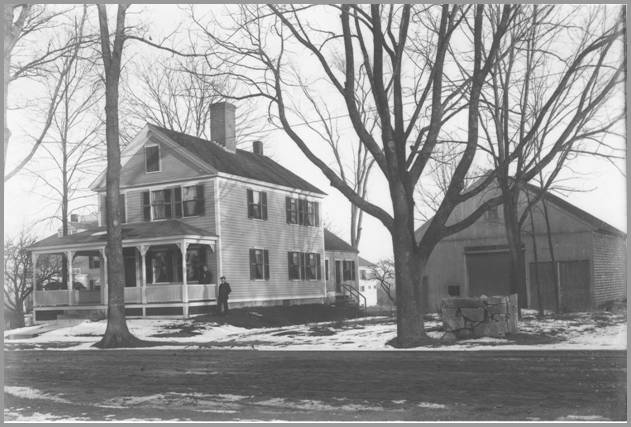
59 MAIN STREET
On November 11, 1909 Charles L. Hildreth photographed the house
at 59 Main Street and recorded it as “Mrs. Emory Whitney’s house.”
The glass plate negative was reprinted by Steve McKenna, 2003.
If we follow the writing style of the “Westford Wardsman” of years past, the following news item from July 2004 would be reported as follows: A recent real estate transaction of interest in the center is the sale of the home at 59 Main Street last owned by Mrs. Rita Everett Miller to Mr. Kenneth J. Tebbetts….
Among the several families that have owned 59 Main Street over the years were Francis and Sarah Proctor, Donald Cameron, Emory and Caroline Whitney, Dr. Thomas Forsley and, lastly, Mrs. Rita Miller. Rita and her husband, Everett, bought the house back in 1945.
It is the Proctor family who was fondly remembered by three former Westford residents. Kate Hamlin (1847-1937) mentioned the family in her “Reminiscences.” She wrote, “Next to the Osgood house was the home of Mr. and Mrs. Proctor. Their front yard was always most attractive in summer because of its tulips and pansies.” Frederick Fisher (1855-1941) had similar memories when he wrote in 1931, “The next house on the left was owned and occupied by Deacon Proctor. Like most of the residents of Westford Centre he was retired from active business. He set out and carefully nurtured the large shade trees which still line that side of the street.” However, it is the memory of staid Leonard Wheeler (1864-1937) who lived at 66 Main Street that brings a smile. He wrote, “Francis Proctor, who lived where Dr. Forsley is now had been a state prison warden or maybe only a guard. Madam was a careful housekeeper. He was heard one evening to ask, ‘Have you wiped up the sink?’ ‘Yes’ was the reply. ‘Then I suppose I can’t have a drink of water.'”
To clarify Kate’s memory of Main Street, the Osgood house mentioned above sat where the current fire station is on Main Street. The Osgood house was torn down in 1971 when the new station was built. Kate doesn’t mention the town hall and the house at 57 Main Street as neither had been built when she was walking through town. In 1870, the town hall was built and the land for it came by eminent domain from the easterly half of the Osgood property. The house at 57 Main was built in 1911 when J. Henry Colburn bought the lot. So when Kate says, “Next to the Osgood house was the home of Mr. and Mrs. Proctor,” she was correct, and a cow pasture probably filled the intervening gap.
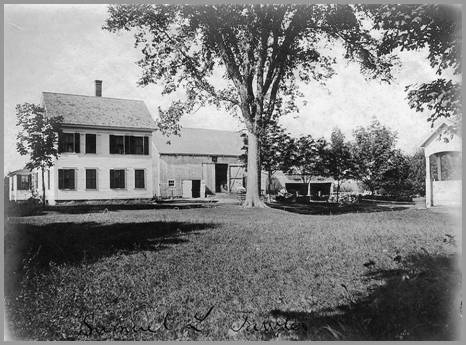
Samuel L. Taylor Place, 70 Lowell Road. 1902 Quincy Day photo
A 1945 newspaper clipping at the Westford Museum describes the fire that destroyed the barn at 70 Lowell Road on November 17 that year, shown in the picture above. This had long been the home of Samuel L. Taylor and was known as the Old Oaken Bucket Farm. Sam Taylor, as you folks who have read the old “Westford Wardsman” newspaper will recall, was one of the writers for that paper. For some reason, Sam never threw away any of his newspapers. It made no difference to him that the Boy Scouts had paper drives, he wouldn’t part with his collection and piled them up year after year in the left end of the barn. Between the pile and the wall of the house was an oil tank for the kitchen range.
By 1945, Sam was no longer living, and the house was owned by his son, William Reuben Taylor, who lived on Stony Brook Road. The farm became a rental, and the Pulsifer family was living in it on November 17th. Son, David Pulsifer discovered the fire and yelled for help. Arnold Wilder was in the area and went to the Polley farm, known as the Morning Glory farm, next door at 76 Lowell Road to call the fire department.
When the fire department arrived they could immediately see the seriousness of the situation. A barn fire with newspapers and kindling-dry potato boxes stacked to the rafters, and an oil tank, all attached to the ell where the kitchen was located which was attached to the main house.
The article says, “The fire gained entrance into the ell, but the damage to the other part of the house was only from hasty removal of the furniture.” Part of that hasty removal was a fireman named Albert Eaton who was upstairs and discovered a bedroom with several oil paintings of the Taylor ancestors. Breaking a window, he began throwing the painting out. As Arnold Wilder tells it, the pictures weren’t much to speak of, he probably did the family a favor, but those gold-leaf frames had to have been worth something.
Mrs. Taylor, meanwhile, came running down from her house on Stony Brook Road yelling, “get Edith out of the barn.” Edith was the horse, but unbeknownst to Mrs. Taylor, the horse hadn’t been living in the barn for several years. Edith was happily munching hay next door at the Polley farm.
The house was saved and today John and Kristen Smith are the newest residents of the Old Oaken Bucket Farm sans barn.
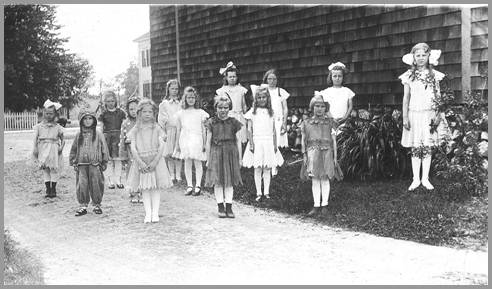
“St. Andrew’s Church Play, 1920”
As early as 1895, Episcopalian church services were held in Forge Village in the recreation hall owned by the Abbot Worsted Company. In 1903 St. Andrew’s Mission was built in Forge Village at 25 Pleasant Street. It was a mission church of St. Andrew’s Episcopal Church in Ayer. The Ayer church had started as a mission church of the Groton School in 1896.
In 1961, St. Mark’s Mission of the Diocese of Massachusetts came into being, continuing the history and congregation of the Forge Village Mission of St. Andrew’s. Needing larger space, a new church, St. Mark’s, was built at the corner of Cold Spring and Graniteville Roads, and was dedicated in 1964. The building at 25 Pleasant Street then became a residence.
Does anyone know the names of these actors and actresses from 1920, shown above, on the picture postcard?
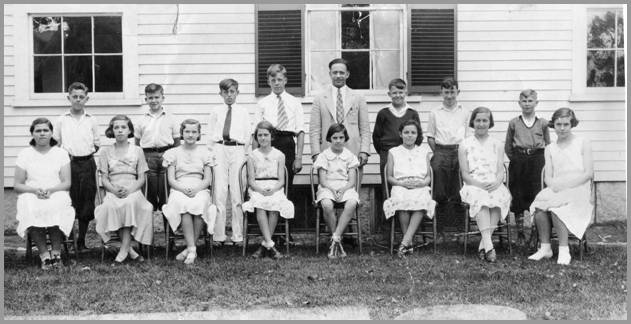
Tom Daly provided this photograph taken outside the Cameron School in Forge Village. Tom had two uncles Bob and Tony Panneton. His uncle, Tony Panneton who graduated from the Cameron School in 1933, is first in the back row on the left. Others who graduated that year were Leonard W. Cavanaugh, Irene M. Dudevoir, Frederick J. Fitzpatrick, Barbara M. Gray, James E. Harrigan, Herbert Kazeniac, Margaret P. Kelly, Robert P. Lord, Luba Marshall, Alda M. Milot, Peter Savocik, Helen Sechovich, Josephine M. Sosnowski, Edmund T. Szylvian, Josephine A. Woitowicz and Nellie Worobey. The principal was Peter Perry.
Mr. Daly says, “My grandfather, Thomas Panneton, came to Forge Village back in the early 1900s. When he first came to Wesford he stayed in the building that used to be where Spinners is today [the Prescott Tavern]. Eventually the family lived on 9 Orchard street in Forge until recently when my Uncle Tony passed away. Thomas worked for Abbot Worsted in the furnace room first as a fireman then later in the basket weaving shop. I have a old wall clock that my grandfather received as a gift from Abbot Worsted before the company moved down south in 1957. It was given to him for his many long years working there. It used to hang in one of the offices, I think, and my grandfather hung it in his cellar by his work bench to remind him of his time working in the mill.”
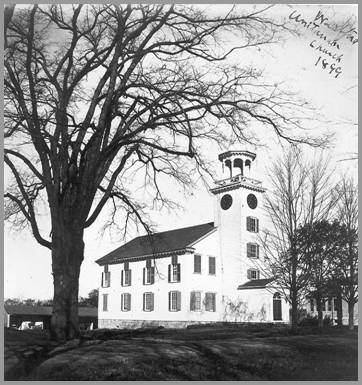
Photo by Quincy W. Day
Article by June W. Kennedy & Jane Carpenter.
Two hundred and seventy-five years ago, Massachusetts law required that both a church and a settled minister be in place before the incorporation of a town could occur. Westford began as the town of Chelmsford and, after 13 years of petitioning, the Massachusetts General Court granted the settlers of the West Precinct of Chelmsford permission to gather as a separate religious society. The first meetinghouse was built in 1725, and the Reverend Willard Hall, fresh out of Harvard College, had settled in town by 1727. On September 23, 1729, with church and minister in place, the Town of “Wesford,” soon changed to Westford, was incorporated.
For the first century of Westford’s history, community and religious life were so intertwined that each left a deep imprint on the other. The church meetinghouse was the center of all religious, social and political life. From 1729 to 1867, town meetings were held there. Votes of town committees and church committees frequently dealt with the same matters. The town clerk was the church clerk. The meetinghouse had no exclusive religious sanctity, but was used indifferently for all its meetings: those of business as well as those of worship; prayer on Sunday and politics on Monday. The Declaration of Independence was read before the town at the First Parish meetinghouse in 1776. In her diary, Kate Hamlin states that a ball was held there in honor of President James Buchanan. Westford Academy graduation exercises were held in the meetinghouse until 1907.
The First Parish Church United of Westford will host an historical tour at its 1794 meetinghouse on Saturday, September 18 from 1 p.m. to 4 p.m. The free event will feature historic artifacts, storytelling, music and tours of the bell tower.
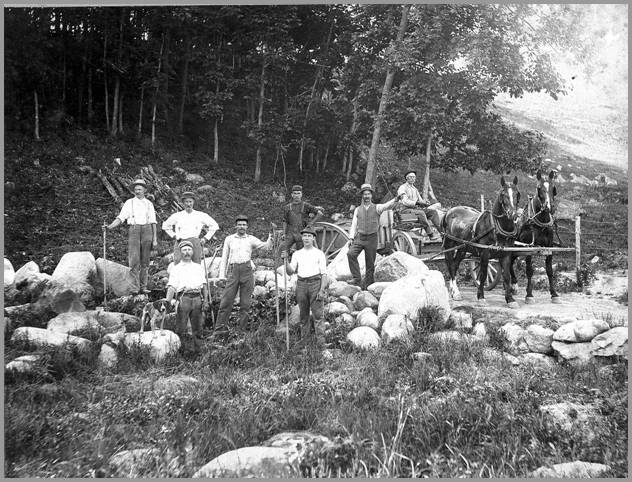
Even Westford’s stonewalls have history
Were it not for the information written on the back of this photograph, it would be almost impossible to know where or even if this picture were taken in Westford. A roving photographer, F. E. Bennett working for the C.E. Powers Photography Company of Nashua was responsible for taking this Westford scene. Information provided by the Nashua Public Library from their old city directories indicated the Powers company was active in Nashua, NH only from 1895 to 1898. Now we can narrow down the date of the photo to a four year time period. Fortunately, the donor of the photograph, Rita Miller, wrote more information on the back which identified the location as Hildreth Street. She also identified the man in the center who is pointing as the foreman and her grandfather, Willey Wright.
Building and re-building stonewalls was an off-season occupation for farmers. Serving as boundaries and fences, the old walls are still a unique feature of our landscape, and as anyone knows who has wrestled boulders into place, only to have them tumble down again, it takes a lot of skill and muscle to build a good wall.
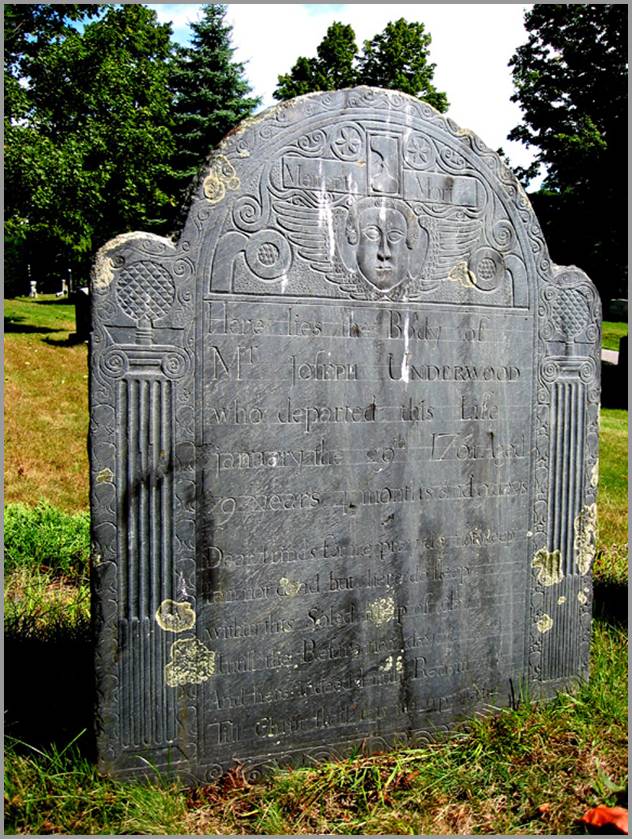
(Photo by Dan Lacroix, Sept. 2004)
As we come to the end of our 275th celebration in Westford, this seemed to be the right time to talk about Fairview Cemetery, which will soon be listed on the National Register of Historic Places. All of the old, surviving cemetery stones in Fairview are absolutely unique, and they, too, have history to share. It is through probate records that the history of many early gravestones and their carvers is preserved.
In 1756 a stone carver by the name of William Park, already over 50 years of age, left his home and family in Glasgow, Scotland and came to the new world where he settled in Westford. William Park stayed here briefly, but by 1760 he was “warned out” according to the “History of Westford.” Whether or not he was still living in town in 1761 is not certain, but when Joseph Underwood died on January 29, 1761, at age 70, in town, William Park was hired to carve his gravestone. It is Mr. Underwood’s probate records which show that his estate paid William Park one pound sixteen shillings for carving his stone. The photograph above is Joseph Underwood’s stone in Fairview Cemetery.
William removed from Westford and went to live in Groton where in 1765 his wife, Ann, and his two younger sons, James and Thomas, arrived from Scotland. His oldest son, John, was working for the Duke of Argyle on his castle in Inverary and would not arrive for another two years.
William died in 1788 in Groton, but his sons, John and Thomas continued the stone carving business. They probably obtained their slate from the Pin Hill area of Harvard, MA, where leases were given out to quarry the stone from the surface of the hill. The name Park is now locally famous for slate gravestone carvings. Some of their stones are signed “Park, Groton” at the bottom, but mostly it is the style of their work which is recognized. What an honor to have had Mr. Park carve your stone and to have his work survive right here in Westford.
Joseph Underwood was born in Reading, MA in 1681 and came to that part of Chelmsford which would become Westford in 1729. Joseph was a large land-holder in the center of town. In 1744, Capt. Thomas Read, Lt. Jonas Prescott, Jr. and John Abbot were chosen as a committee to deal with Mr. Joseph Underwood about buying a piece of land to become a training field. In 1748 Joseph was paid 5£ for that piece of land. Then in 1767 another piece was added to it. Today we know the training field as our town common – the spot where dancing and dining were held on the ever so successful 275th gala on September 18, 2004.
Thank you all for your contributions to this 275th series in pictures and for your kind words and occasional corrections; and to Peter Costa and his staff of the “Westford Eagle” for encouraging this series.
